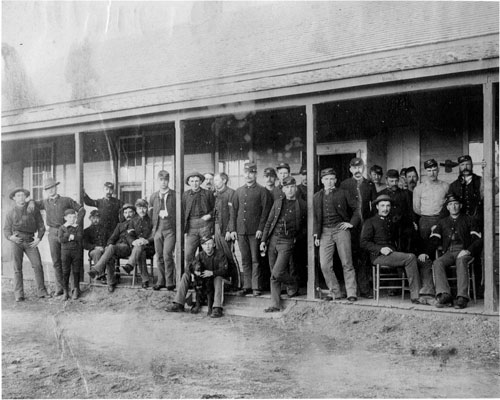We’ve launched a new web portal! Visit findhistory.nd.gov to search our collections.
Due to a road closure, the Killdeer Mountain Battlefield State Historic Site is temporarily closed.
Fort Buford Records | Private Wilmot Sanford | Diary

Private Wilmot Sanford of New Hampshire, enlisted in the Army in 1872 at the age of twenty-three. He served in Company D of the 6th Regiment, Infantry, serving at least three years of his five year enlistment at Fort Buford at the confluence of the Yellowstone and Missouri Rivers.
By the time of Sanford’s service, the Army was providing more nutritious food for soldiers. His notes about meals indicate that vegetables (usually potatoes and onions) and fruits (plum duff and apples) were regularly served at post meals. At least one winter meal included tomatoes, but that is the only time that tomatoes – a vegetable very high in Vitamin C - showed up on Sanford’s food list during that particular winter.
Several pages of the diary are transcribed here to show the relative importance of the dietary entries. He mentioned food in detail several times a week. Other entries or portions of entries indicate some variety of food and the importance of the steamboats in supplying the remote post with vegetables.
Among the foods mentioned are kraut, cabbage, mush, syrup, apples and applesauce, plums, pork, beef, potatoes, onions, beans, rice, and molasses. Corn, peaches (canned) and tomatoes were mentioned only once, but corn meal in the form of mush or fritters (fried corn meal mush) appeared frequently. Occasionally, the men supplemented their diets with wild meats including antelope, venison, and prairie chickens.
The arrival of the first steamboat in the spring was an important event. The ships brought all kinds of supplies, but most importantly potatoes and other vegetables for both officers and for enlisted men. The pay of privates, about $13 a month at that time, prevented Sanford from purchasing many meals or supplementary food from the Leighton and Jordan, the post traders. Officers, however, routinely purchased food for their families (which did not draw rations) from the post trader and from the steamboats. In 1875, the first steamboat was the Josephine from Yankton which arrived on May 4th.
Sanford’s diaries have been transcribed and published in North Dakota History Vol 33, No. 4 Fall 1966 (335-378) and North Dakota History volume 52, No. 3 Summer 1985 (2-40)
Address:
612 East Boulevard Ave.
Bismarck, North Dakota 58505
Get Directions
Hours:
State Museum and Store: 8 a.m. - 5 p.m. M-F; Sat. & Sun. 10 a.m. - 5 p.m.
We are closed New Year's Day, Easter, Thanksgiving Day, and Christmas Day. We are closed at noon Christmas Eve if it falls on Mon.-Thurs. and are closed all day if it falls on Fri.-Sun.
State Archives: 8 a.m. - 4:30 p.m. M-F, except state holidays; 2nd Sat. of each month, 10 a.m. - 4:30 p.m. Appointments are recommended. To schedule an appointment, please contact us at 701.328.2091 or archives@nd.gov.
State Historical Society offices: 8 a.m. - 5 p.m. M-F, except state holidays.
Contact Us:
phone: 701.328.2666
email: history@nd.gov
Social Media:
See all social media accounts